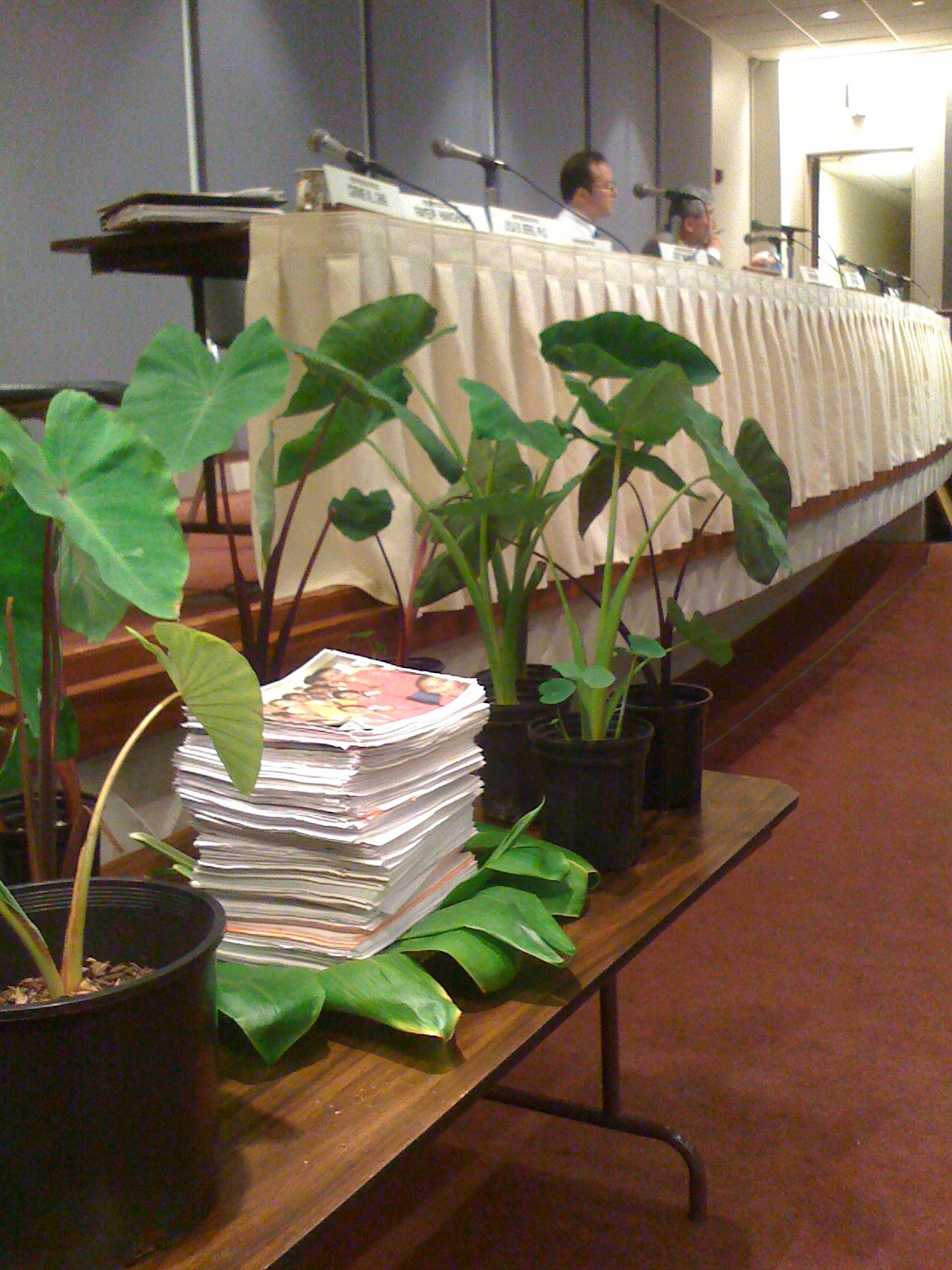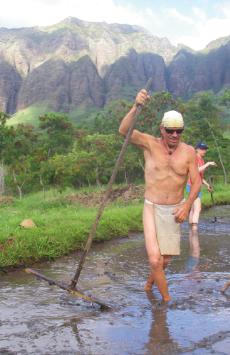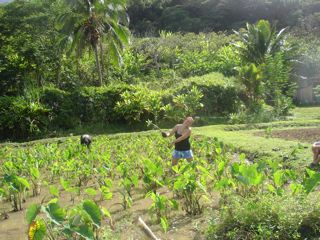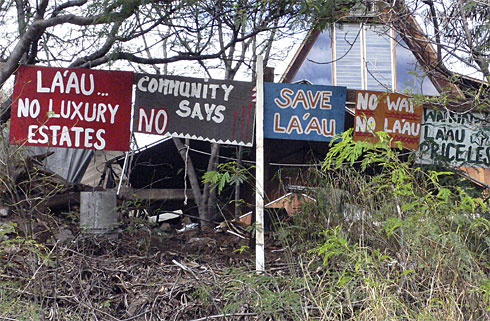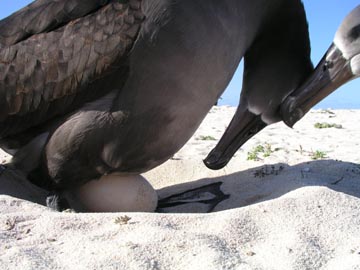Blog
News, updates, finds, stories, and tidbits from staff and community members at KAHEA. Got something to share? Email us at: kahea-alliance@hawaii.rr.com.
6,000 & growing...
from Marti:
Here is a letter that was published today in the Honolulu Advertiser (one of the few so far):
GENETIC MODIFICATION
CHANGING KALO ERODES HAWAIIANS’ LIFELINE
My mother used to serenade me with songs about exotic places. Travelogues of oceans, forests and island sweethearts. This is how she passed on knowledge. Songs reflecting simpler times and storytellers of the past. Our people were more disconnected than ever. Being Hawaiian was not popular. So to sing her aloha was her moment of self determination.
Her spiritual integrity impressed upon me indigenous ways of knowing. “Leave that popolo berry! It wants to grow there.”
If someone was to have told her she could no longer share limu among her classmates without a permit she would have sighed, “That’s why we going die out.” But she would respectfully accept it. She felt people saw her particular relationship with the ‘aina as peculiar.
Replanting kalo is the living lifeline that holds the stories of our past. Changing the genetic makeup of kalo will erode that lifeline.
Hawaiians are now re-establishing their priorities in maoli culture. A moratorium on varieties of maoli kalo and introduced kalo as specified in SB 958 is needed for more reasons than just keeping steroid-like pumped up food off our tables.
It’s needed so we can pass on to our keiki more than just “stones.” We can pass on the story of Haloa.
-Meala Bishop
Waiahole kalo farmer, Kane’ohe
To submit testimony on the protection of taro, click here.
what needs to be changed
The KAHEA office has been abuzz all weekend–the fax machine on overdrive–as staff and volunteers plowed through the task of organizing and compiling thousands of letters of testimony in support of a 10-year moratorium on genetic modification of kalo (taro).
Mahalo to everyone who has lent their voice in support of Hawai`i’s traditional farmers! As Bryna likes to point out: “Without the right to protect our traditional food resources what will remain of our culture or our rights?”
From Bryna:
The shared kuleana to save kalo and traditional farming is not only historical or cultural–it is a political imperative for Hawaii’s survival on this rapidly changing planet.
Thousands of letters of personal testimony, expert opinions and petitions for protection speak to the importance of pure kalo and traditional farming techniques for Hawaii. This is a truly pono moment in the history of humanity- thousands and thousands of people of all backgrounds are joining together to protect a plant species from irreversible genetic modification- and honoring an ancient ancestor and endangered Hawaiian lifestyle.
The message from the people is simple and clear: Haloa is family, Kalo is life, being in the Lo`i is living! It is not appropriate, necessary nor acceptable to engineer kalo into a genetically modified organism. The observation of the kalo farmers is profound: the kalo plant is not what needs to be changed.
Kalo Farmers' Call to Action - Hearing for SB958
From our friends at Na Kahu O Haloa:
Aloha to all who love Taro and honor Haloa! He keiki aloha na mea kanu. Beloved children are the plants.
Mahalo to everyone who has come out to support Hawai‘i’s traditional farmers! Your strong support & efforts scored a Hearing for SB958 – 10 Year Moratorium on Genetically Modified & Patented Taro! Mahalo piha!
WEDNESDAY MARCH 19th, 8:30 am, till about 12:30
This is the last committee hearing for this bill, House Agricultural Committee. (If it passes unamended it will then go to the House floor for the 3rd reading.)
Come support kalo at this historic event, your presence is Haloa’s blessing! Please spread the word! That day is also Hawaiian Caucus Day at the Capitol, hosted by Rep. Mele Carroll, from 10am-4pm- featuring a variety of cultural activities, speakers and performances.*
In the meantime we all have the hard work of convincing the politicians to PASS the bill without inappropriate changes. Hawai‘i’s farmers, our unique ecosystem… and Haloa need your help to make this happen. So, please take a few moments to:
SEND YOUR LETTER OF TESTIMONY! write now!
Let there be no doubt that Hawaii wants to protect kalo from genetic modification! We have gotten lots of statements of support from taro farmers throughout the islands, but the decision-makers need to hear from all of us. Don’t be shy, every letter is important!
*TESTIMONY LETTERS NEEDED BY Thursday, MARCH 13th!*
Four Easy Ways to Submit Testimony:
(1) email it to: *NaKahuOHaloa@gmail.com** And if can, use your *letterhead* and attach it to the email as a PDF or doc.
A “two-fer”: When emailing your letter, you can also send it as a letter to the editor, by copying these emails into the “CC” address line when you send us your letter:
letters@honoluluadvertiser.com
letters@starbulletin.com
(2) visit www.KAHEA.org/gmo to submit testimony via our virtual testimony table.
(3) mail your testimony to KAHEA (Attn: Kalo) at
P.O. Box 270112
Honolulu, Hawaii 96827
(4) Fax it to: 1-888-528-6288 (yes, thats 888 not 808 – it’s toll free!!)
VOLUNTEERS
We need volunteers of all ages during these days leading up to the hearing! There are many ways to help Haloa. Formal volunteer internships may be available too! Please contact us if interested! NaKahuOHaloa@gmail.com.
CRUCIAL CALLS TO ELECTED OFFICIALS
Polite persistent phone calls are CRUCIAL to get support of politicians! Please call/fax/email the House Agricultural Committee and ask for support of SB958- a 10 Year Moratorium on Genetic Modification of all varieties of Taro.
Attached is a print out of Ag Committee phone numbers & talking points to pass out to everyone you know. Calls can be repeated everyday, polite persistence pays!
EDUCATIONAL MATERIALS & SPEAKERS
We have a wide variety of educational materials, including films, available to any who are interested. Expert speakers will also volunteer to visit your group to discuss this issue. Contact NaKahuOHaloa@gmail.com.
We hope these resources may be of help to you. Let us know how else we can help you and your community to speak up for Haloa!
200 Luxury Estates a good thing for Molokai?
From Marion:
Last week, KAHEA submitted written testimony to the State Land Use Commission in opposition to “the proposal by Molokai Properties Limited to build 200 luxury estates at La’au Point” which will negatively impact the environment and culture.
Our comments point out that: although there is overwhelming scientific evidence supporting that the main Hawaiian Islands serve as foraging and breeding grounds for monk seals and millions of dollars for research and monitoring have been set aside, little has been done by the state and federal governments to permanently protect habitat — like that La’au point. The truth is that the single most important action we can take to save monk seals is provide them places of permanent pu`uhonua, true and forever sanctuaries. Monk seals survive best when left alone in a place where humans do not dominate the landscape, in sanctuaries marked only by the presence of blowing sands and waves crashing against jagged lava formations at the water’s edge.
Further, because “Molokai is one of a few communities that still have resources to sustain traditional subsistence”, they need to be honored and protected to ensure the perpetuation of these traditional practices of gathering for their families and communities. The reason why these practices still remain today have to do primarily with the fact this shoreline is undeveloped and difficult to access.
The proposed development will limit access to this 5-mile stretch of coastline by providing only two points of entry, one at each end of the proposed coastline development even though the “state law requires that public access to the shoreline be available every quarter mile” which is clearly not honored in this proposal.
The Molokai community has voiced their undying concern regarding the relentless and greedy development plans of Molokai Properties Limited. The community has no interest in having a community split and culturally and socially restricted by the influx of big money. Today, they are standing up, protecting their inherent rights to collect what they need from the mountains to the oceans that keeps their culture alive.
To make this place no more than a picture postcard tropical beach destination is to strip it of its most fundamental and uniquely Hawaiian identity. We stand together with communities on Molokai to share the view that the sea, land, culture, and people remain vital in marking this land as a Hawaiian place.
Click here to read comments on the EIS:
KAHEA’s comments in opposition to the development at La’au Point
Office of Hawaiian Affairs’ Comments on the development La’au Point
being heard? yup, it feels good.
From Marti:
I admit to still being on cloud 9 about the recent announcement of the hearing officer’s decision on KAHEA’s standing to participate in the contested case on the research permit violations in the NWHI. Hooray! What an amazing affirmation of the power of showing up.
We have attended every possible hearing about research permits to the NWHI and raised serious concerns about the lack of enforcement action on these research permit violations. We have shown up to talk about the lack of standards to determine who should be allowed up there and the lack of best practices to ensure their activities do no harm, as the law requires. We have again and again said that these research permit violations are a serious breach of public trust, and that rules should apply equally, no matter who is in violation–everyone should be held to the same standard: fishers, researchers, sight-seers, everyone.
I wish had a dime for every time I’ve heard someone say with regards to these research violations, “Trust me, researchers would never harm the resource.” Talk about totally missing the point. The point is that researchers, like everyone else, are obligated to know and follow the rules put in place to protect this fragile public trust resource. Simple as that. The fact is most people don’t ever to intend to harm the environment, but they do because they don’t follow the rules, don’t think that their actions could have an impact.
It was incredibly empowering to sit at that hearing table – elbow to elbow with HIMB’s attorney and the Attorney General on behalf of DLNR – and have an impartial officer of the court listen to all three sides. We had an equal opportunity to present arguments and evidence. And in the end, this impartial officer said, “Yes, KAHEA brings a meaningful perspective to this discussion and should be party to this case.”
Wow. For that, my faith in the public decision-making process is renewed. We couldn’t have asked for a more meaningful affirmation of our voice and role.
Too often the voices of those most directly affected by the decisions of officials are marginalized or even lost altogether. It is easy for money and politics to drive decisions. But when those influences are stripped away and those who have nothing to give but love for our ‘aina – people like Uncle Buzzy – can sit at a table and be heard on equal terms with all rest… that is when the best decisions are made.
It was these people – those without power or money – that led the struggle for the strongest possible protections in the Northwestern Hawaiian Islands and successfully made their voice heard. And it will be these same people who will continue to ensure that those protections are fully implemented and enforced…. because these protections are nothing if they aren’t enforced, fully.
Hooray, hooray today–for the little guy!
Highlights of KAHEA’s concerns about lack of DLNR enforcement (from our recent webpage update):
The violations were first reported to DLNR staff in May 2006 while the vessel was still in the NWHI. But DLNR staff failed to notify the proper enforcement division, DOCARE, until late February 2007, almost a year after the infractions occurred. No investigators met the ship when it docked in Honolulu to inspect what the researchers brought back with them.
“This is a major problem,” said Marti Townsend, Program Director for KAHEA. “The history of close working relationships between DLNR and HIMB staff has clearly called into question DLNR’s ability to be objective and properly enforce the law.”
Before the incidents were investigated by DOCARE and voted on by the Land Board, staff with the Aquatics Division of DLNR attempted to negotiate a penalty with the researchers at HIMB. The staff brought the enforcement action before the BLNR twice – first in January 2007 and again in July 2007. Both times the staff recommended that the Land Board impose weakened penalties against the HIMB researcher, side-stepping the Refuge’s strict “one strike” law that prohibits future permits to be granted to past permit violators.
“Given all of the tremendous public support for the strongest possible protections, and political will for the creation of these protections, it is astonishing that personal friendships and financial ties still seem to determine the near absolute lack of enforcement of NWHI rules,” said Townsend.
State-Appointed Hearing Officer Affirms KAHEA's Standing in Historic Decision
Investigation of HIMB Research Permit Violations for Northwestern Hawaiian Islands Expanded,
Contested Case Hearing Officer Recommends Long-Time Advocate, KAHEA, Be Party to the Case
HONOLULU – In a historic move, citing KAHEA’s long history of actions to protect the NWHI, state-appointed hearing officer for the Board of Land and Natural Resources, Louis Chang, recommended on Friday that the Board grant KAHEA: The Hawaiian-Environmental Alliance standing as a party to a landmark case concerning the first recorded major violations of the state’s new stringent Northwestern Hawaiian Island Refuge rules. “The Northwestern Hawaiian Islands are a public trust resource, and we welcome this affirmation of our kuleana to ensure that the strict rules we worked so hard to establish are fully enforced so that this fragile and unique place is well-protected,” said Vicky Holt-Takamine, KAHEA Board of Directors President.
Federal and state officials have testified that in 2006, during one of the first major research expeditions permitted to conduct extractive activities in the state’s newly created no-take Refuge, scientists from the Hawai’i Institute of Marine Biology (HIMB) — including a former state Department of Land and Natural Resources employee –cultivated coral disease bacteria in the NWHI, transported bacteria within and outside of the NWHI, and attempted to bring bacteria cultures to the Main Hawaiian Islands, in violation of the state’s strict permit requirements and state and federal quarantine and customs laws regarding the transport and import of disease organisms. Officials testified that an HIMB disease researcher harvested, cultivated, and transported live coral within the NWHI, dumping wastewater from the coral tank overboard as they traveled between islands. These actions, which occurred in 2006, represent serious violations of state permit conditions designed to protect the NWHI from the spread of disease and invasive species, as well as state and federal laws.
The NWHI Refuge specifically establishes a ‘do no harm’ standard for all activities there,” said Louis “Buzzy” Agard, former NWHI resident who fished commercially there and later fought for strong conservation measures. “This should mean human activity in the NWHI is strictly limited so as to leave no human footprint on what is left of this delicate marine ecosystem.” According to Agard, “If this were a fishing violation, they’d throw the book at them. But this is a case of colleagues and friends of DLNR staff. There seems to be a double standard for these violators.”
Efforts by the Hawaii Institute of Marine Biology (HIMB) to block enforcement of strict state rules protecting the Northwestern Hawaiian Islands State Refuge were dealt a blow with the publication of the recommendation on Friday indicating that — as per KAHEA’s request — the investigation into apparently illegal activities would now be broadened and that KAHEA has standing in the case. There have been persistent rumors, however, of back-room attempts to lobby Board members regarding this case and to encourage DLNR to take extraordinary measures to overturn the hearing officer’s recommendation.
“This is historic,” said Miwa Tamanaha, Executive Director of KAHEA. “We have serious allegations of research permit violations in the face of more people and research vessels heading to the NWHI. What is decided here in this first enforcement action against research permit violations will affect all future decisions about how to fully protect this uniquely Hawaiian no-take marine environment.”
The Land Board is expected to rule on the recommendation March 7, 2008.
You can see the full case filings and get more information at www.KAHEA.org
(top photo from keoki, and bottom photo from kahea.org.)
our world gets bigger.
UPDATE from Rich on 2/29: Got word yesterday that the House Finance Committee passed HB839 with amendments!

From email from Rich ma over at Beach Access Hawai’i in Kailua:
I was going to use a clever subject line for this email — something like, “Show me the money!” because that’s what it comes down to now. We’re asking the State to pony up bucks to do this beach access survey and report. But a little earlier I got a phone call from someone in our group…
His mother passed away this morning and he wanted the phone number of another BAH member, because he needed help getting a canoe so he could scatter her ashes in the waters off the Mokulua islands. He said she loved Lanikai and Kailua Beach, and this is what she wanted.
Until I got involved with this cause, I didn’t know him or the paddler he wanted to get in touch with. I think it speaks volumes about what the beaches and ocean means to all who live in Hawaii. It connects us, and brings us together. You know those people who put up gates on “private” roads? Their world has gotten smaller, while our circle of friends is growing and getting bigger.
You can support the bill he’s talking about–HB839– by showing up to the hearing and/or emailing in your testimony to the finance committee. FINtestimony@Capitol.hawaii.gov (contact Rich at figeli001@hawaii.rr.com if you need sample testimony to follow.)
From BAH: The meeting will be in Room 308 at the State Capitol building. HB839 is at the top of the agenda, so testimony will probably start around 11:15 am, and could continue for a half hour to an hour depending on how many people show up.

